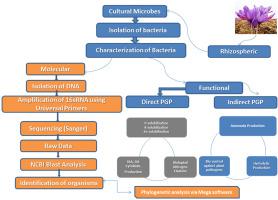Microbial Pathogenesis ( IF 3.8 ) Pub Date : 2021-01-08 , DOI: 10.1016/j.micpath.2021.104734 Akhtar Rasool 1 , Mohammad Imran Mir 2 , Muhammad Zulfajri 3 , Marlia Mohd Hanafiah 4 , Syeda Azeem Unnisa 5 , Mohammed Mahboob 6

|
Saffron (Crocus sativus L.) is an important plant in medicine. The Kashmir Valley (J&K, India) is one of the world's largest and finest saffron producing regions. However, over the past decade, there has been a strong declining trend in saffron production in this area. Plant Growth Promoting Rhizobacteria (PGPR) are free living soil bacteria that have ability to colonize the surfaces of the roots and ability to boost plant growth and development either directly or indirectly. Using the efficient PGPR as a bio-inoculant is another sustainable agricultural practice to improve soil health, grain yield quality, and biodiversity conservation. In the present study, a total of 13 bacterial strains were isolated from rhizospheric soil of saffron during the flowering stage of the tubers and were evaluated for various plant growth promoting characteristics under in vitro conditions such as the solubilization of phosphate, production of indole acetic acid, siderophore, hydrocyanic acid, and ammonia production and antagonism by dual culture test against Sclerotium rolfsii and Fusarium oxysporum. All the isolates were further tested for the production of hydrolytic enzymes such as protease, lipase, amylase, cellulase, and chitinase. The maximum proportions of bacterial isolates were gram-negative bacilli. About 77% of the bacterial isolates showed IAA production, 46% exhibited phosphate solubilization, 46% siderophore, 61% HCN, 100% ammonia production, 69% isolates showed protease activity, 62% lipase, 46% amylase, 85% cellulase, and 39% showed chitinase activity. Three isolates viz., AIS-3, AIS-8 and AIS-10 were found to have the most plant growth properties and effectively control the growth of Sclerotium rolfsii and Fusarium oxysporum. The bacterial isolates were identified as Brevibacterium frigoritolerans (AIS-3), Alcaligenes faecalis subsp. Phenolicus (AIS-8) and Bacillus aryabhattai (AIS-10) respectively by 16S rRNA sequence analysis. Therefore, these isolated rhizobacterial strains could be a promising source of plant growth stimulants to increase cormlets growth and increase saffron production.
中文翻译:

藏红花(Crocus sativus L.)根际隔离的原生根瘤菌的促进植物生长和抗真菌资产
藏红花(番红花L.)是医学上的重要植物。克什米尔山谷(印度J&K)是世界上最大,最优质的藏红花产区之一。但是,在过去的十年中,该地区的藏红花产量一直呈下降趋势。促进植物生长的根瘤菌(PGPR)是一种自由生存的土壤细菌,具有在根部表面定殖的能力,并具有直接或间接促进植物生长和发育的能力。使用高效的PGPR作为生物灭活剂是另一种可持续的农业实践,可以改善土壤健康,提高谷物产量质量和保护生物多样性。在本研究中,在块茎开花期从藏红花的根际土壤中分离出总共13个细菌菌株,并在此条件下评估了各种植物促进生长的特性。体外条件,例如磷酸盐的溶解,吲哚乙酸的生产,铁载体,氢氰酸,氨的生产和拮抗作用,通过对罗氏菌和尖孢镰刀菌的双重培养试验。进一步测试了所有分离物的水解酶,例如蛋白酶,脂肪酶,淀粉酶,纤维素酶和几丁质酶的产生。细菌分离物的最大比例是革兰氏阴性杆菌。约77%的细菌分离物显示出IAA产生,46%的显示出磷酸盐增溶作用,46%的铁载体,61%的HCN,100%的氨气产生,69%的分离物显示出蛋白酶活性,62%的脂肪酶,46%的淀粉酶,85%的纤维素酶和39%显示几丁质酶活性。发现三个分离株,即AIS-3,AIS-8和AIS-10具有最大的植物生长特性,并能有效地控制罗氏菌和尖孢镰刀菌的生长。细菌分离物被鉴定为短杆菌弗氏短杆菌(AIS-3),产碱杆菌粪亚种。通过16S rRNA序列分析分别对苯酚(AIS-8)和阿里亚巴芽孢杆菌(AIS-10)进行了分析。因此,这些分离的根际细菌菌株可能是植物生长刺激剂的有希望的来源,以增加increase子的生长和增加藏红花的产量。



























 京公网安备 11010802027423号
京公网安备 11010802027423号